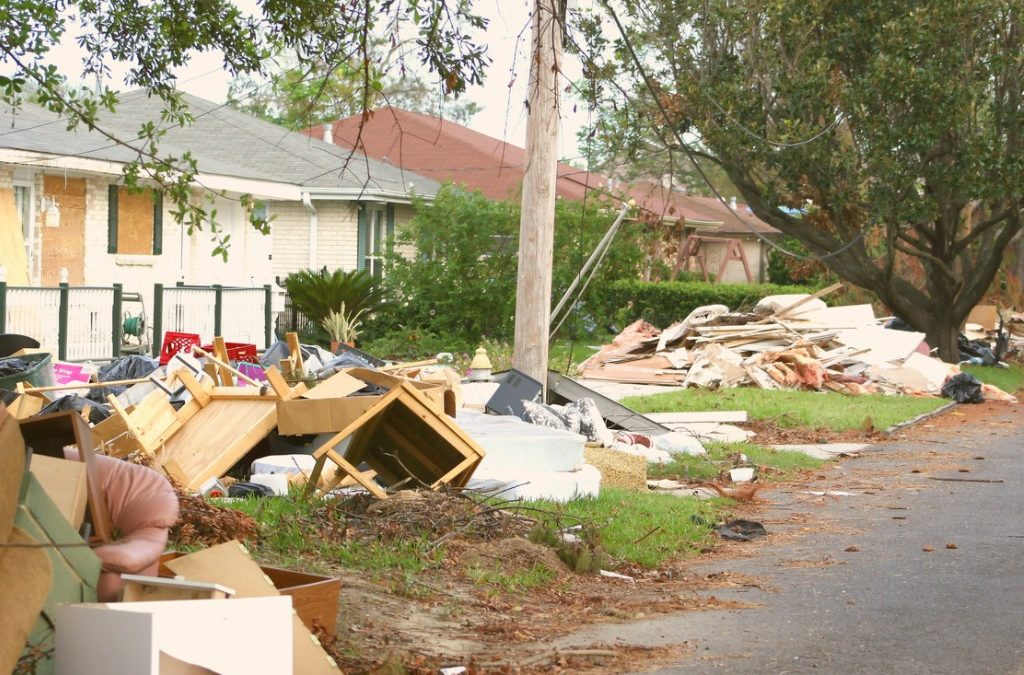After flood waters recede and you have access to your home or building, it is time to start the cleanup process. The following questions and answers are intended to assist you in moving through this process.
What precautions should Homeowners take to preserve evidence prior to the insurance adjuster’s arrival?
All insurers are different, so the best approach is to call the insurer and ask what measures can be taken prior to the appraiser’s arrival. Their instructions should be followed assuming they will respond in a reasonable time. Get the name and callback number for the representative in case anyone questions actions taken per their instructions.
Once it’s safe to proceed:
- Shut off natural gas or propane supply valve
- Open the main breaker to shut off all power to the residence
- If there is any damage to utilities around the residence such as a downed power line or gas leak, report these and ensure any hazards are neutralized before proceeding
- Open all windows and doors
- If available, establish circulation using large fans
- Utilize a Sharpie or other dark marker to identify the high water line on the interior drywall
- Photograph all affected areas to the extent possible, capturing the marked high water lines; if a tape measure or ruler is available to place along the wall, that would document depth within the room
- Before beginning disposal, locate and retrieve salvageable important records, especially related to the house
- Remove water logged belongings as needed for access to the floor and walls
- Remove Be sure to take photos of the appliances and record their model and serial numbers as possible. Often these items are left in the yard during work and can be stolen. If stolen they may not be covered under your claim if they are stolen before the adjuster sees them. During past storms, spoiled and rotting food rendered refrigerators unsalvageable, and if this is the case, it is best not to open them, but rather place straps around the doors and put them on the street for disposal.
- Open walls:
- Remove wet drywall beyond the high water line
- Remove wet insulation
- Remove carpeting and other floor surface coverings to expose the wood subfloor or concrete It is recommended this be completed after removal of wall coverings to prevent the need to clean the foundation or rough floor surfaces.
- Remove tile wall coverings and supporting substrate where they are flooded.
- If flooding reached a second floor, the first floor ceiling and all walls will need to be opened
- Apply a fungicide/disinfectant such as Constan 20 or a similar product to the exposed framing materials to limit mold growth. Do not use Chlorine cleaners such as Clorox that may actually promote mold growth.
- You will need to leave the structure open for a sufficient time to allow the moisture content of the framing and wall systems to drop to a safe level.
- Have the structure evaluated by a NABIE engineer or other building inspection engineer prior to starting repair work to evaluate the moisture content of the structure and to determine the need for any further remediation or repairs.
What is the process for obtaining FEMA assistance?
- Certificate of Occupancy
- Deed
- Mortgage records
- Homeowner’s policy
- Flood insurance policy
- Mortgage statement
- Records regarding any previous flood claims that may have been made on the property due to past events
What is the remediation process? Should other chemicals be used instead of bleach?
One of the most important considerations is to stay out of floodwaters to the extent possible. Floodwaters are considered as “black water” full of petroleum, chemicals and biohazards such as bacteria from waste from overflowed sanitary sewer systems. There are a number of invisible hazards such as open drains, energized power lines, snakes, etc. Consideration should be given to not entering a house until waters have receded to the point that the house can be accessed and cleared without operating in the floodwater. Where floodwaters are unavoidable, measures should be taken to avoid direct contact with skin such as use of heavy rubber boots, gloves, waders, etc.
I have an older home should I be concerned about Lead Based Paint during remediation?
If a qualified environmental firm tests an older property for ACM and LBP and it is found to be free of both, and documented in a signed written report, work could proceed. Otherwise, containment measures must be followed and a qualified environmental remediation firm should be utilized. Self-test kits locally available may not be reliable or may be improperly used or interpreted and the risks are too great to rely upon them.
Manufacture of LBP and ACM were discontinued in the late 70s but continued use was not. While these materials were no longer manufactured for use in residential construction, materials on hand were likely still used for several years after production stopped. So there is no date certain as to when these were no longer used, but use should have been minimal to non-existent after about 1985.
LBP and ACM become significant hazards when disturbed. Federal and State laws govern the proper removal, storage and disposal or encapsulation of these materials. Licensed and certified contractors using trained personnel in full protective equipment perform this work operating within a containment. Therefore, disturbance of these materials by untrained, unprotected persons will violate laws and create a significant health hazard to those performing the work and others nearby. Both materials create significant health hazards when ingested or airborne and inhaled.
Homeowners with older properties that have never been checked or remediated should rely on professional environmental services or contractors for testing and remediation where LBP and/or ACM are detected. The health and legal risks to the homeowner and volunteers are not worth proceeding in unsafe conditions.


Recent Comments